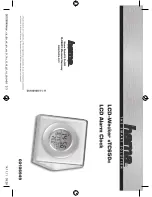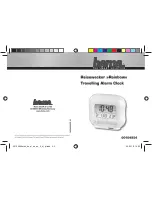
CONNECTION:
Connect directly as
shown; use the in-
cluded DLP-N3
doorlock harness
and simply reverse
its lock and unlock
wire colors
. If the
system is a 5 Wire
Reversal system, a
DLS and two relays
must be used.
3 Wire Positive Doorlocks using the AL-100-H Control Unit outputs
Door
Motors
Doorlock Switch
DLP-N3
Blue
wire to
switch
Lock
wire.
DLP-N3
Green
wire to
Switch
Unlock
wire.
Vehicle's Doorlock
Relay Control Unit
Unlock
Lock
DLP-N3 harness Red
connector plugs into
the control module’s
Red port.
+12V
5 Wire Reversal Rest At Ground Systems
differ from the Negative and Positive Pulse
systems in the fact that there are no relays or doorlock control unit. In this type of system, the
switches themselves supply the positive voltage directly to the doorlock actuators, and, more
importantly, provide the return ground path. The correct doorlock interface for this type of
system is the optional DLS and 2 relays. The important thing to remember is the wires in this
system
rest at ground,
which means that the vehicle wires must be "opened", or cut, to properly
make the connections between the AL-100-H and the vehicle’s doorlock system.
Examine the wires on the back of the switch. Normally five wires will be found. Of these
wires, one will be constant 12 volts positive, regardless of the switch's position. Two wires
Page - 27
White and Brown wires. Because of this polarity-learning circuitry, these two wires
must be
connected
when the AL-100-H is first supplied Power and Ground. Also, if the White or Brown
wire is not needed, the unused wire(s)
should be grounded
.
An additional and related wire is found on the 5-pin Main Harness. If the Gray wire on this
harness receives 12 Volt Positive pulse, the AL-100-H will disarm; this wire may be connected
to a Positive trunk release wire, thus disarming the AL-100-H when remote trunk release is
utilized.
Five basic types of system connections are used to install the AL-100-H as an “add-on”
alarm, and are referred to as Types 1 through 5. A diagram of each of these five Types are
shown on the following pages.
How to test to determine Type 1 , Type 2 or Type 3 connections
(
Type 4
is for Ford
vehicles with Negative pulse doorlock switches and
Type 5
is a universal connection).
If the VOM or DMM indicates any change in polarity, it can be determined that the vehicle's
remote keyless entry unit back feeds power (Positive or Negative) to the door switch when the
transmitter is used. If the doorlock switches are configured to switch Positive pulses and none
of the doors unlock after cutting the wire, the
Type 1
wiring diagram may be used. If after
cutting the vehicle's unlock wire the driver door only still unlocks, then use the
Type 3
Connection. If the VOM or DMM indicates no change in polarity, then it can be determined
that the vehicle's remote keyless entry unit does not back feed power (Positive or Negative)
to the door switch when the transmitter is operated, use the
Type 2
Connection.
Step 1 -
Connect a Volt/Ohm Meter or Digital MultiMeter to the door
switch
wires.
Step 2 -
Use the
transmitter
to lock and unlock the doors-
do not use either door switch
.
Page - 6
CONNECTION:
Connect directly as
shown; use the in-
cluded DLP-N3
doorlock harness
and simply reverse
its lock and unlock
wire colors
. If the
system is a 5 Wire
Reversal system, a
DLS and two relays
must be used.
3 Wire Positive Doorlocks using the AL-100-H Control Unit outputs
Door
Motors
Doorlock Switch
DLP-N3
Blue
wire to
switch
Lock
wire.
DLP-N3
Green
wire to
Switch
Unlock
wire.
Vehicle's Doorlock
Relay Control Unit
Unlock
Lock
DLP-N3 harness Red
connector plugs into
the control module’s
Red port.
+12V
5 Wire Reversal Rest At Ground Systems
differ from the Negative and Positive Pulse
systems in the fact that there are no relays or doorlock control unit. In this type of system, the
switches themselves supply the positive voltage directly to the doorlock actuators, and, more
importantly, provide the return ground path. The correct doorlock interface for this type of
system is the optional DLS and 2 relays. The important thing to remember is the wires in this
system
rest at ground,
which means that the vehicle wires must be "opened", or cut, to properly
make the connections between the AL-100-H and the vehicle’s doorlock system.
Examine the wires on the back of the switch. Normally five wires will be found. Of these
wires, one will be constant 12 volts positive, regardless of the switch's position. Two wires
Page - 27
White and Brown wires. Because of this polarity-learning circuitry, these two wires
must be
connected
when the AL-100-H is first supplied Power and Ground. Also, if the White or Brown
wire is not needed, the unused wire(s)
should be grounded
.
An additional and related wire is found on the 5-pin Main Harness. If the Gray wire on this
harness receives 12 Volt Positive pulse, the AL-100-H will disarm; this wire may be connected
to a Positive trunk release wire, thus disarming the AL-100-H when remote trunk release is
utilized.
Five basic types of system connections are used to install the AL-100-H as an “add-on”
alarm, and are referred to as Types 1 through 5. A diagram of each of these five Types are
shown on the following pages.
How to test to determine Type 1 , Type 2 or Type 3 connections
(
Type 4
is for Ford
vehicles with Negative pulse doorlock switches and
Type 5
is a universal connection).
If the VOM or DMM indicates any change in polarity, it can be determined that the vehicle's
remote keyless entry unit back feeds power (Positive or Negative) to the door switch when the
transmitter is used. If the doorlock switches are configured to switch Positive pulses and none
of the doors unlock after cutting the wire, the
Type 1
wiring diagram may be used. If after
cutting the vehicle's unlock wire the driver door only still unlocks, then use the
Type 3
Connection. If the VOM or DMM indicates no change in polarity, then it can be determined
that the vehicle's remote keyless entry unit does not back feed power (Positive or Negative)
to the door switch when the transmitter is operated, use the
Type 2
Connection.
Step 1 -
Connect a Volt/Ohm Meter or Digital MultiMeter to the door
switch
wires.
Step 2 -
Use the
transmitter
to lock and unlock the doors-
do not use either door switch
.
Page - 6


































